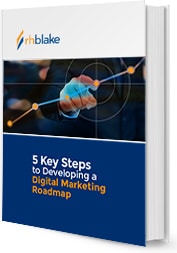Manufacturing Marketing Website Best Practices: How to Engage Engineers
Written by Dan Konstantinovsky
Strategic Marketing, RH Blake
![]()

For many manufacturing marketers of complex offerings, creating awareness and preference with engineers is a key goal. Typically, the primary objective includes capturing engineers’ attention and then driving their interest to / back to your website where they can learn more about the potential value you can provide.
Although for many manufacturing marketers this is the right approach, we frequently see significant opportunities for engagement and lead generation improvement once an engineer lands on a website page. Too often, manufacturing-focused brands overlook how to best align their websites to this distinct engineering audience. And as a result, lead conversion, and ultimately profit potential, suffers.
To help ensure your manufacturing-focused website is maximizing opportunities with engineers, it helps to first clearly understand engineers’ motivations and their distinct preferences.
Manufacturing Marketing Website Best Practices: How to Engage Engineers
 Written by Dan Konstantinovsky
Written by Dan Konstantinovsky
Strategic Marketing, RH Blake
![]()
For many manufacturing marketers of complex offerings, creating awareness and preference with engineers is a key goal. Typically, the primary objective includes capturing engineers’ attention and then driving their interest to / back to your website where they can learn more about the potential value you can provide.
Although for many manufacturing marketers this is the right approach, we frequently see significant opportunities for engagement and lead generation improvement once an engineer lands on a website page. Too often, manufacturing-focused brands overlook how to best align their websites to this distinct engineering audience. And as a result, lead conversion, and ultimately profit potential, suffers.
To help ensure your manufacturing-focused website is maximizing opportunities with engineers, it helps to first clearly understand engineers’ motivations and their distinct preferences.
10 Common Engineering Persona Attributes – May Include a Combination of:
- Extremely risk averse – personal, professional and enterprise impacts
- Part of a larger team
- Focused on learning new ideas/ways to solve existing challenges
- Prefer self-educating – 75% of engineering decision makers don’t want to hear from suppliers until they are in the later stages of the buying process.
- Invest 8.3 hours per week consuming content online.
- Relatively more hesitant to provide contact information online
- Their favorite content types are accurate, visual, and well-cited:
- Heavily leverage existing relationships to gather insights and inputs into decision making
- Prefer to work with facts and binary decisions
- Avoid making recommendations unless they have a great deal of certainty;
Once you have a deeper sense of how the engineers you’re looking to create relationships with think, feel, learn and communicate, the next step is to consider how to best align these insights with your website structure, organization and content.
Below are 3 key steps every manufacturing marketer should consider taking to ensure their website maximizes engagement opportunities with engineers.
1. Build trust with direct and indirect proof points
Leading manufacturing marketers understand the value of case studies and references. However, we also understand that getting end-customers to agree to provide their project information is easier said than done.
One way to build proof points on your website and in your marketing program is through an organized award program that recognizes specific customers for attributes that would be helpful for them to share broadly. For example, perhaps one of your customers experienced a safety milestone, engineering breakthrough, or a more effective way to manage suppliers and partners. Consider creating an award that recognizes this action and see whether your customer would be willing to share this news externally including on your website. Not only will this help your customer reinforce or enhance their position in the market, it will give you the opportunity to indirectly communicate you work together. A win, win.
While named testimonials are also extremely valuable for trust-building, it may not be possible or practical to get a major customer to agree to be identified on your site. In that case, offering unidentified application stories that mention valuable customer attributes such as “Leading material handling supplier in the Northwest (and the specific problem they were facing)” can be extremely persuasive. And because engineers appreciate “prove it to me” more than “tell it to me,” consider incorporating visuals including videos, infographics and engaging presentations to accompany the case study text.
2. Minimize asking for contact information (initially)
As a manufacturing marketer of offerings that may require long sales cycles, you know that a lead can be worth hundreds of thousands or even millions of dollars. This, coupled with the fact that many manufacturing executives use lead generation as a key marketing evaluation metric, means you may tend to place a heightened emphasis on lead capture throughout the site.
RH Blake’s Voice of the Customer data shows that engineers are approximately 60% less likely to provide you their contact information compared to non-engineers. As a result, if you’re overly ambitious and early with asking for contact details and not considering the value-exchange fit, you’re likely impacting the long-term success of your marketing program. Engineers will feel skeptical earlier than most people. Instead, ask for contact information after value and engagement has been delivered.
For example, rather than asking for contact information to view a webinar, consider letting the engineer view the webinar for a short period and then ask for their contact details. This way, the engineer would have already understood the potential value of the remaining webinar and in return is more likely to give you their contact data.
A similar approach can be used with technical guides, cross-reference databases and CAD drawings. Provide the engineer a chance to see the value and if your content is valuable enough, the engineer is more likely to provide their contact details.
3. Provide certainty with expert, data-driven content
Engineers are naturally more hesitant than most to believe supplier claims; to better demonstrate your expertise, capabilities and thought leadership, data-driven, solution-oriented content is critical.
In fact, 62% of engineers said that showing them a new way to solve an established problem would get them to rethink their business needs.
To do this, consider how you may be able to minimize risk for your customers with data. What decisions are your customers making based on hunch, “best practice,” experience, or just plain guessing? By offering engineers a way to be more certain in their decisions, not only will you be able to develop deeper relationships with them, you will also help them educate others in their organization with more authority, and in turn, help you take steps toward earning the business.
Say your solution helps customers improve their production throughput while minimizing cost. Consider interviewing your last 50 customers to uncover why certain customers were able to gain more value out of your solution that others. What specifically are the leading businesses doing that the others–including your prospects–could learn from?
In addition to these types of insights, consider how you could segment this report in a way that makes it easy for your engineer prospects to communicate your value to others within their organization. These types of insights create differentiation, build trust and help you win opportunities faster.
Conclusion – To engage engineers, start with trust, not features or benefits
Manufacturing marketers looking to displace suppliers or create meaningful awareness with engineers in the hopes of becoming top-of-mind on the next project face significant marketing challenges. Engineers are hard to reach, challenging to engage and difficult to convince. Having a marketing program and website that deeply understands and addresses the nuances of how engineers think, act and feel in their respective target industries will help ensure the next time you’re driving traffic to your website, it has a higher likelihood of converting into an opportunity.


